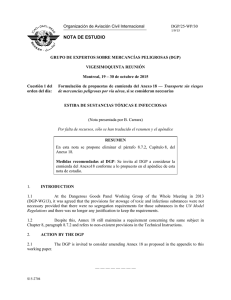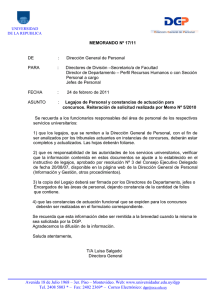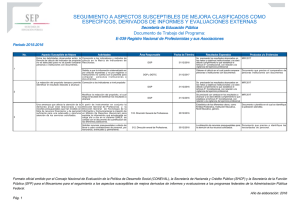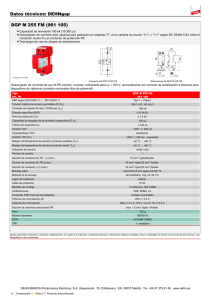nota de estudio
Anuncio
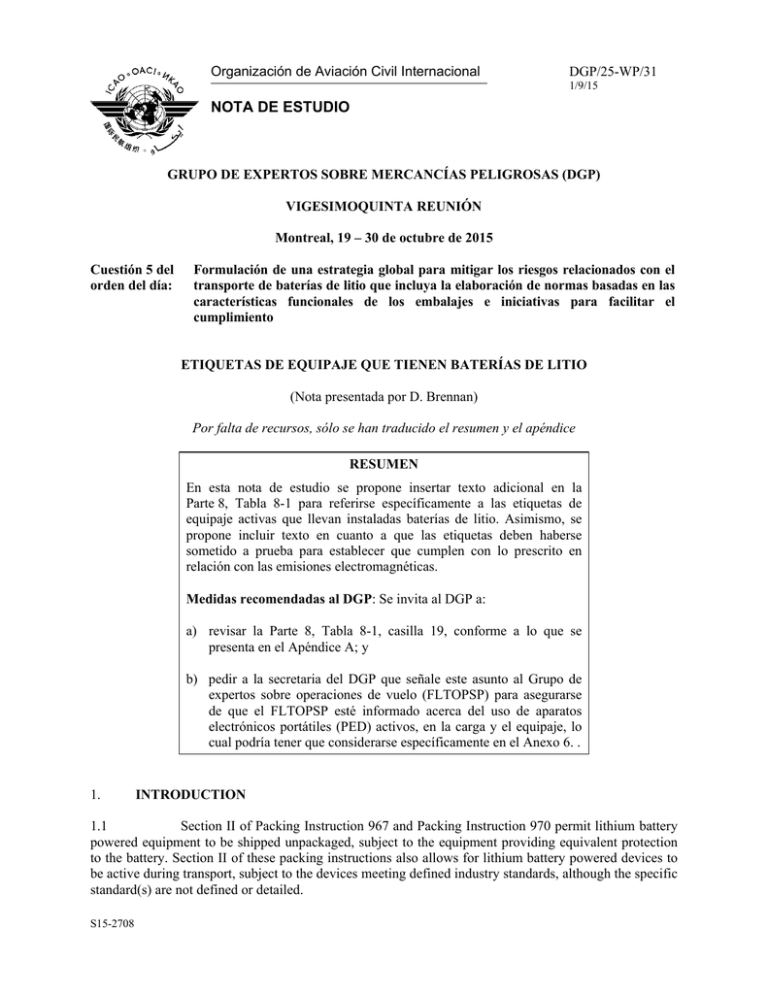
Organización de Aviación Civil Internacional DGP/25-WP/31 1/9/15 NOTA DE ESTUDIO GRUPO DE EXPERTOS SOBRE MERCANCÍAS PELIGROSAS (DGP) VIGESIMOQUINTA REUNIÓN Montreal, 19 – 30 de octubre de 2015 Cuestión 5 del orden del día: Formulación de una estrategia global para mitigar los riesgos relacionados con el transporte de baterías de litio que incluya la elaboración de normas basadas en las características funcionales de los embalajes e iniciativas para facilitar el cumplimiento ETIQUETAS DE EQUIPAJE QUE TIENEN BATERÍAS DE LITIO (Nota presentada por D. Brennan) Por falta de recursos, sólo se han traducido el resumen y el apéndice RESUMEN En esta nota de estudio se propone insertar texto adicional en la Parte 8, Tabla 8-1 para referirse específicamente a las etiquetas de equipaje activas que llevan instaladas baterías de litio. Asimismo, se propone incluir texto en cuanto a que las etiquetas deben haberse sometido a prueba para establecer que cumplen con lo prescrito en relación con las emisiones electromagnéticas. Medidas recomendadas al DGP: Se invita al DGP a: a) revisar la Parte 8, Tabla 8-1, casilla 19, conforme a lo que se presenta en el Apéndice A; y b) pedir a la secretaria del DGP que señale este asunto al Grupo de expertos sobre operaciones de vuelo (FLTOPSP) para asegurarse de que el FLTOPSP esté informado acerca del uso de aparatos electrónicos portátiles (PED) activos, en la carga y el equipaje, lo cual podría tener que considerarse específicamente en el Anexo 6. . 1. INTRODUCTION 1.1 Section II of Packing Instruction 967 and Packing Instruction 970 permit lithium battery powered equipment to be shipped unpackaged, subject to the equipment providing equivalent protection to the battery. Section II of these packing instructions also allows for lithium battery powered devices to be active during transport, subject to the devices meeting defined industry standards, although the specific standard(s) are not defined or detailed. S15-2708 DGP/25-WP/31 -2- 1.2 These same allowances though are not specifically included in the passenger provisions in Part 8, Table 8-1. Increasingly though there are devices, such as permanent bag tags and electronic bag tags which are both placed external to the passenger checked baggage, and are active during transport. 1.3 In May 2015, the United States Federal Aviation Administration (FAA) issued an Advisory Circular (AC 91.21-1C) (see Appendix B) with some specific recommendations that we believe should be considered by the DGP with respect to dangerous goods and also should be brought to the attention of the Flight Operations Panel (FLTOPSP) for consideration for Annex 6 — Operation of Aircraft. 1.4 In the advisory circular, the FAA identifies that operators should be able to make use of information provided by the aircraft manufacturers with respect to the aircraft’s tolerance for electromagnetic radiation from personal electronic devices (PED). PED in this context also includes active devices such as electronic or permanent baggage tags. 1.5 For PED such as permanent baggage tags the advisory circular puts the onus on the manufacturer of the device to demonstrate that the baggage tags do not interfere with aircraft systems. In effect the manufacturer of any active PED must be able to certify to the user that the device complies with the requirements of a defined standard, in this instance RTCA DO-160G — Environmental Conditions and Test Procedures for Airborne Equipment, Section 21, Category H. 1.6 It is proposed to bring specific provisions into Part 8, Table 8-1, 19) to make provision for these active baggage tags that are starting to be used by operators and which will become more common over time. 1.7 In the text proposed for inclusion into Table 8-1, a limit of 0.3 g for the lithium content for a lithium metal cell and 2.7 Wh for a lithium ion cell is proposed for these active baggage tags. These numbers though have been placed in square brackets. The DGP is invited to consider if these limits are appropriate. 2. 2.1 ACTION BY THE DGP The DGP is invited to: a) revise Part 8, Table 8-1, item 19 as shown in Appendix A to this working paper; and b) request that the DGP Secretary bring this to the attention of the FLOPSP Secretary to ensure that the FLTOPSP are aware of use of active PED in cargo and baggage that may be required to be specifically provided for within Annex 6. ———————— DGP/25-WP/31 Apéndice A APÉNDICE A ENMIENDA PROPUESTA DE LA PARTE 8 DE LAS INSTRUCCIONES TÉCNICAS Parte 8 DISPOSICIONES RELATIVAS A LOS PASAJEROS Y A LA TRIPULACIÓN Capítulo 1 DISPOSICIONES PARA MERCANCÍAS PELIGROSAS TRANSPORTADAS POR LOS PASAJEROS O LA TRIPULACIÓN Partes de este capítulo resultan afectadas por las discrepancias estatales US 15; véase la Tabla A-1 1.1 MERCANCÍAS PELIGROSAS TRANSPORTADAS POR LOS PASAJEROS O LA TRIPULACIÓN ... Sí Sí Se requiere aprobación del explotador En la persona Artículos u objetos Equipaje de mano Equipaje facturado Ubicación Se debe informar al piloto al mando Tabla 8-1. Disposiciones relativas a mercancías peligrosas transportadas por los pasajeros o la tripulación Restricciones ... Artículos de consumo 19) Aparatos electrónicos portátiles (como relojes de pulsera, calculadoras, cámaras, teléfonos celulares, computadoras portátiles, videocámaras, etiquetas de equipaje electrónicas) Aparatos electrónicos portátiles (incluidos los dispositivos médicos) que contienen pilas o baterías de metal litio o de ión litio (los objetos que contienen pilas o baterías de metal litio o de ión litio cuyo propósito primordial es proporcionar energía para el funcionamiento de otro dispositivo, deben portarse Sí No No a) para uso personal de los pasajeros o la tripulación; b) deberían llevarse en el equipaje de mano; c) ninguna batería debe sobrepasar lo siguiente: — para las baterías de metal litio, un contenido máximo de 2 gramos de litio; o — para las baterías de ión litio, una capacidad nominal de 100 Wh; DGP/25-WP/31 Se requiere aprobación del explotador En la persona Artículos u objetos Equipaje de mano Equipaje facturado Ubicación Se debe informar al piloto al mando A-2 Apéndice A como baterías de repuesto de conformidad con lo dispuesto en la casilla siguiente) Restricciones d) si estos aparatos se transportan como equipaje facturado, deben tomarse medidas para evitar que se activen accidentalmente; y e) si los aparatos se transportan fuera del equipaje, como en el caso de las etiquetas de equipaje electrónicas, el aparato debe proteger de manera adecuada la batería instalada dentro del mismo; f) los aparatos, como las etiquetas de equipaje electrónicas y los registradores de datos, que no pueden generar una emisión peligrosa de calor, pueden transportarse cuando intencionadamente se llevan en estado activado. Para aparatos activos, el fabricante debe certificar que el aparato satisface las condiciones de RTCA DO-160G o su equivalente nacional. Durante su transporte, el aparato no debe emitir señales alarmantes, (como alarmas sonoras o luces estroboscópicas). Los aparatos activos que se llevan en el equipaje de mano o sobre el mismo deben estar diseñados de modo que tengan, como mínimo, dos medios independientes para desconectarlos completamente, desconectar las funciones de celular o móvil, o una o combinación de ambas cosas, durante el vuelo. Ninguna batería debe sobrepasar lo siguiente: — para las baterías de metal litio, un contenido de [ 0,3 gramos] de metal litio; o — para las baterías de ión litio, una capacidad nominal de [2.7 Wh]; y eg) las baterías y las pilas deben ser de un tipo que satisfaga las condiciones de cada una de las pruebas del Manual de Pruebas y Criterios de las Naciones Unidas, Parte III, subsección 38.3. ... ———————— DGP/25-WP/31 Apéndice B APÉNDICE B USE OF PORTABLE ELECTRONIC DEVICES ABOARD AIRCRAFT (Advisory Circular (AC 91.21-1C), FAA) DGP/25-W WP/31 Apéndice B B-2 DGP/25-W WP/31 B-3 Apéndice B DGP/25-W WP/31 Apéndice B B-4 DGP/25-W WP/31 B-5 Apéndice B DGP/25-W WP/31 Apéndice B B-6 DGP/25-W WP/31 B-7 Apéndice B DGP/25-W WP/31 Apéndice B B-8 DGP/25-W WP/31 B-9 — FIN — Apéndice B
